It has always seemed a bit improbable that Catherine Russell, the vibrant and exciting swing singer, is the daughter of Luis Russell, the leader of one of the very best jazz bands of 1929, 90 years ago. However consider the much more extreme case of Alberta Martin, the last widow of a Civil War veteran. She passed away in 2004 at the age of 97, nearly 140 years after the war had ended! In 1927, the 21-year old had married an 81-year old veteran of the Confederate army, William Martin. Even more bizarre is that they had a son ten months later and, after her husband died in 1931, she married his grandson! And yes, that means that her four-year old son was also her father-in-law, which of course has nothing to do with this article!
Luis Russell, Carline Ray, and Catherine Russell are part of different generations of jazz artists, each having significant careers. Luis Russell was born August 6, 1902, in Careening Cay, Panama. He studied guitar, violin, and organ before settling on the piano. His first important gig was accompanying silent movies in 1917.
The biggest break of his life occurred in 1919 when Russell won $3,000 in a lottery. He used the money to move with his mother and sister to New Orleans. For the next five years, the pianist was part of the local jazz scene, playing with local groups including in 1923 with one led by clarinetist Albert Nicholas. When Nicholas moved up North, Russell became the band’s leader. In late 1924, Russell joined the exodus, moving up to Chicago to play with Doc Cook.
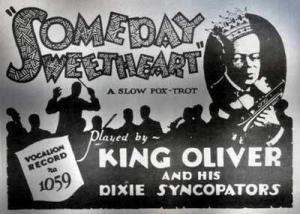 During 1925-26, Russell was a member of King Oliver’s Dixie Syncopators. On March 10, 1926 he made his recording debut, accompanying singer Ada Brown on two numbers and leading an all-star sextet called Luis Russell’s Hot Six on “29th and Dearborn” and “Sweet Mumtaz.”
During 1925-26, Russell was a member of King Oliver’s Dixie Syncopators. On March 10, 1926 he made his recording debut, accompanying singer Ada Brown on two numbers and leading an all-star sextet called Luis Russell’s Hot Six on “29th and Dearborn” and “Sweet Mumtaz.”
The unit, with cornetist George Mitchell, trombonist Kid Ory, Nicholas on clarinet, alto, and soprano, Barney Bigard on tenor, and banjoist Johnny St. Cyr in addition to the leader, was partly drawn from Oliver’s group which recorded “Snag It” and “Too Bad” the following day.
Russell made other recordings that year with Oliver (including “Deep Henderson,” “Jackass Blues” and “Sugar Foot Stomp”) and led another session, this time by his Heebie Jeebie Stompers and featuring cornetist Bob Shoffner, trombonist Preston Jackson, clarinetist Darnell Howard, Barney Bigard (playing the best tenor of his career) and Johnny St. Cyr. After going to New York with King Oliver, Russell recorded some further titles with the cornetist during 1927-29.
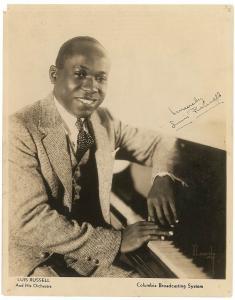 Luis Russell was never a major pianist and rarely ever soloed, but he was an inventive arranger and a stable bandleader. In October 1927, he took over the George Howe band, performing at the Nest Club for a year before moving to the Saratoga Club. He recorded three numbers by his Burning Eight in early 1929 (with the nucleus of his future group plus trumpeter Louis Metcalf), recorded for the first time with Louis Armstrong‘s Savoy Ballroom Five (“I Can’t Give You Anything But Love” and “Mahogany Hall Stomp”), and was on trumpeter Henry “Red” Allen’s first two sessions as a leader. The latter had Allen utilizing Russell’s band except for second trumpeter Bill Coleman being absent.
Luis Russell was never a major pianist and rarely ever soloed, but he was an inventive arranger and a stable bandleader. In October 1927, he took over the George Howe band, performing at the Nest Club for a year before moving to the Saratoga Club. He recorded three numbers by his Burning Eight in early 1929 (with the nucleus of his future group plus trumpeter Louis Metcalf), recorded for the first time with Louis Armstrong‘s Savoy Ballroom Five (“I Can’t Give You Anything But Love” and “Mahogany Hall Stomp”), and was on trumpeter Henry “Red” Allen’s first two sessions as a leader. The latter had Allen utilizing Russell’s band except for second trumpeter Bill Coleman being absent.
The Luis Russell Orchestra of 1929-31 was one of the finest jazz groups of the time. It consisted of four major soloists (Henry “Red” Allen, trombonist J.C. Higginbotham, clarinetist Albert Nicholas, and altoist Charlie Holmes), a pair of talented but under featured players (Bill Coleman and tenor-saxophonist Teddy Hill), and one of the top rhythm sections of the era (rhythm guitarist Will Johnson, bassist Pops Foster, drummer Paul Barbarin, and Russell). The band recorded 18 songs during 1929-30 including such gems as “Feelin’ The Spirit,” “Jersey Lightning,” “Saratoga Shout,” and “Louisiana Swing.”
Russell’s arrangements, which sometimes evolved through several themes (particularly on “Saratoga Shout”), set off the soloists very well and mixed together New Orleans jazz with early swing. The band also accompanied Louis Armstrong for a few months (appearing on some of his records including “St. Louis Blues”) and recorded as a smaller combo on dates headed by Allen, Higginbotham, Victoria Spivey, Sweet Pease Spivey, and (without Russell) Jelly Roll Morton.
The prime period did not last long due to the Depression. There was one further record date in 1931 and one (with cornetist Rex Stewart featured) in 1934. In 1935 the Luis Russell Orchestra became the backup band for Louis Armstrong, working steadily but mostly anonymously behind the star. While the group still had impressive players and there were some good spots for trombonist Higginbotham, the orchestra no longer had its own personality. In 1940 a move to modernize the band resulted in a lot of turnover and tenor-saxophonist Joe Garland taking over from Russell as Armstrong’s musical director. However Russell remained as the orchestra’s pianist until 1943, even recording on the session that Armstrong made with Sidney Bechet.
In 1946 Luis Russell made a final comeback, putting together a new swing-oriented big band and recording 20 songs for the Apollo label. However the only notable name in his personnel was the still-active drummer Roy Haynes, the swing era was quickly ending, and the recordings are not particularly memorable. Russell, who was still just 44, permanently dropped out of jazz. In his later years he ran a candy and gift store, worked as a chauffeur, and taught music.
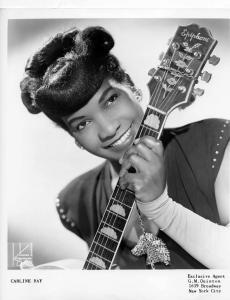 In 1956 the 54-year old Luis Russell married 31-year old Carline Ray. Born April 21, 1925, in Manhattan, Ray was a talented musician from an early age, playing rhythm guitar and string bass. After hearing some of the bands on 52nd Street and seeing Billie Holiday sing, she was inspired to play jazz. A professional musician by 1941, she enrolled that year at Juilliard, graduating as a composition major in 1946.
In 1956 the 54-year old Luis Russell married 31-year old Carline Ray. Born April 21, 1925, in Manhattan, Ray was a talented musician from an early age, playing rhythm guitar and string bass. After hearing some of the bands on 52nd Street and seeing Billie Holiday sing, she was inspired to play jazz. A professional musician by 1941, she enrolled that year at Juilliard, graduating as a composition major in 1946.
Work was not plentiful for female instrumentalists but Carline Ray got lucky and became a member of the International Sweethearts Of Rhythm, the top female jazz big band, as a guitarist and singer. She was in the band near the end of its existence, making her recording debut with them in 1946 and appearing on film in three of their short Soundie films. She would not record in a jazz setting again for 22 years but Carline Ray stayed busy. She worked with Erskine Hawkins in 1948, had a trio in the 1950s with bassist Edna Smith and drummer Pauline Braddy (who had both been with the Sweethearts of Rhythm), and earned a Master’s from the Manhattan School Of Music.
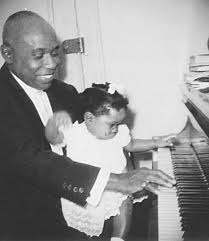 In 1956 Luis Russell and Carline Ray not only got married but had their only child, Catherine Russell. There would never be a family band due to all three Russells being in very different places in their lives. Luis Russell was retired from music although he gave a classical piano recital in 1959. He passed away on December 11, 1963, at the age of 61, when Catherine Russell was just seven.
In 1956 Luis Russell and Carline Ray not only got married but had their only child, Catherine Russell. There would never be a family band due to all three Russells being in very different places in their lives. Luis Russell was retired from music although he gave a classical piano recital in 1959. He passed away on December 11, 1963, at the age of 61, when Catherine Russell was just seven.
Carline Ray Russell always sought to improve herself and not limit herself to only one idiom of music even if swing was her first love. She increased her versatility by taking up the electric bass in the late 1950s and, as late as 1980, received a grant to study the acoustic bass with Major Holley. Among her many assignments through the years were playing commercial music as a session musician, singing backup for Patti Page and Bobby Darin, performing Christmas music in choruses conducted by Leonard Bernstein, and working with the Sy Oliver Big Band.
She recorded with altoist Arnie Lawrence in 1968, sang on a record by organist Jimmy Smith, performed religious music with pianist Mary Lou Williams, and played bass with Carrie Smith, pianist Red Richards, Ruth Brown, the Mercer Ellington Orchestra, trombonist Melba Liston, pianist Marian McPartland, the Universal Jazz Coalition, and pianist Nina Sheldon. Often the only female member of large ensembles (including with the Skitch Henderson Big Band during 1969-79), she became a quiet role model for younger female instrumentalists including Nicki Parrott.
Catherine Russell followed her mother into the music business but took a much different route. She graduated from the American Academy of Dramatic Arts and then became a greatly in-demand background singer. Starting in the early 1980s, Russell performed and recorded with such notables as David Bowie, Steely Dan, Cyndi Lauper, Jackson Browne, Michael Feinstein, Paul Simon, Rosanne Cash, Dr. John, Madonna, Al Kooper, Gloria Estefan, and Diana Ross. Even during that period, her work occasionally bordered on jazz.
Carrie Smith’s 1982 album Only You Can Do It not only has Carline Ray on bass but Catherine Russell contributing background vocals. She also sang on modern jazz albums by Amina Claudine Myers and the Vivino Brothers Band. Her first jazz recording as a lead singer was on bassist Earl May’s Live At Shanghai Jazz in 2000, singing standards with a quartet, but that album was for a tiny label.
Catherine Russell’s career permanently changed with the 2005 album Cat which was released the following year. Seemingly out of nowhere, the 49 year old vocalist became a full-fledged jazz singer, performing jazz and blues dating from the 1920s through the ’50s very credibly. Her 2008 album Sentimental Streak and 2009’s Inside This Heart Of Mine consolidated her success and showed that she was dedicated to performing vintage songs, some from her father’s era.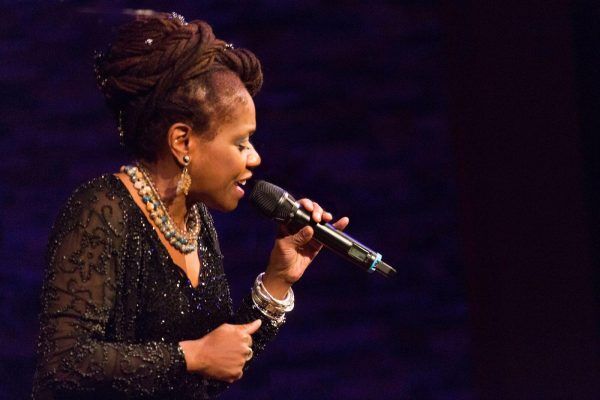
By that time Catherine Russell had a special goal in mind. While her mother Carline Ray Russell had occasionally led groups (including a trio with pianist Bertha Hope called Jazzberry Jam) and she took some vocals on a tribute to the Sweethearts Of Rhythm in 2005 (Kit McClure’s Just The Thing – The Sweethearts Project), she had never led her own album. Her main goal had always been to be a team player, someone in the background who helped the music of others succeed. Catherine thought it was long overdue that her mother be in the spotlight.
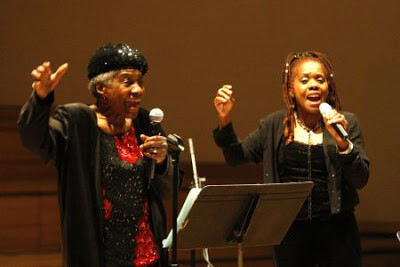 During 2008-11, Carline Ray recorded performances with a rhythm section that would be released on the CarlCat label as Vocal Sides, performing such numbers as “When I Grow Too Old To Dream,” “Somewhere,” “Without A Song,” and “Come Sunday,” singing as well as playing bass. Her daughter, who produced the album, appears on two songs while Carline paid her back by guesting on Catherine’s fourth album, 2011’s Strictly Romancin’, singing “He’s All I Need.”
During 2008-11, Carline Ray recorded performances with a rhythm section that would be released on the CarlCat label as Vocal Sides, performing such numbers as “When I Grow Too Old To Dream,” “Somewhere,” “Without A Song,” and “Come Sunday,” singing as well as playing bass. Her daughter, who produced the album, appears on two songs while Carline paid her back by guesting on Catherine’s fourth album, 2011’s Strictly Romancin’, singing “He’s All I Need.”
Vocal Sides was released shortly before Carline Ray passed away on July 18, 2013 at the age of 88 from a stroke.
Catherine Russell has continued on as one of the most popular and respected swing singers on the scene today. She is featured on the soundtrack album for the HBO series Boardwalk Empire, contributed three songs to the soundtrack of the movie Kill Your Darlings, and appears as a character in the Bolden film (singing “Make Me A Pallet On The Floor”). With the release of Bring It Back, Harlem On My Mind, and Alone Together, she is now up to seven albums as a leader.
And Catherine Russell is making a consistently strong contribution to swinging jazz that would have made Luis Russell and Carline Ray Russell very proud.
Since 1975 Scott Yanow has been a regular reviewer of albums in many jazz styles. He has written for many jazz and arts magazines, including JazzTimes, Jazziz, Down Beat, Cadence, CODA, and the Los Angeles Jazz Scene, and was the jazz editor for Record Review. He has written an in-depth biography on Dizzy Gillespie for AllMusic.com. He has authored 11 books on jazz, over 900 liner notes for CDs and over 20,000 reviews of jazz recordings.
Yanow was a contributor to and co-editor of the third edition of the All Music Guide to Jazz. He continues to write for Downbeat, Jazziz, the Los Angeles Jazz Scene, the Jazz Rag, the New York City Jazz Record and other publications.























